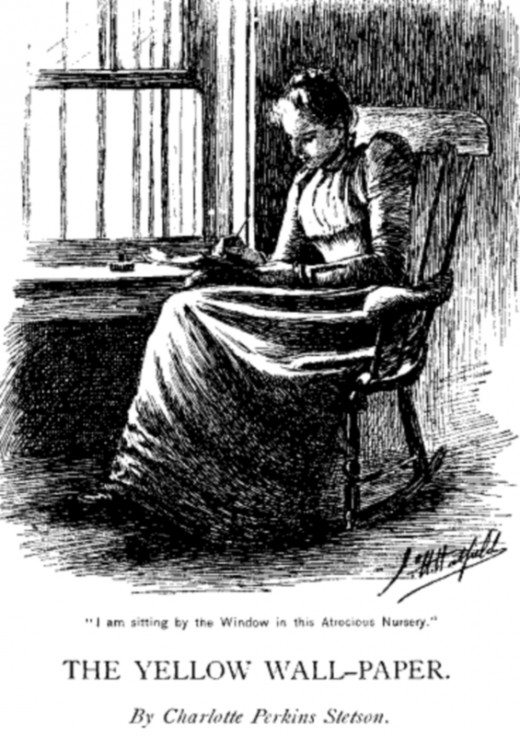The Trouble of Doctor/Patient Roles
A Voice in Society
A key element in Charlotte Perkin Gilman's "The Yellow Wallpaper", is that her language in the story made concepts more complex than what they appeared to be. Simple thoughts are lacking in her story of neglect and abuse.
In other words, her story is subjective. Subjectivity refers to our individual perceptions and interpretations of phenomena.
Thanks to the efforts of exposing the doctor/patient roles in society, the seemingly insignificant gender roles people assumed at the time were exposed, through this short story.
In addition to this, Gilman's writing aimed to release women from the archaic gender roles they faced. Because of work like "The Yellow Wallpaper", women now had a voice in society, where previously the influence of women in society was reduced to being simply the object of a male's desire, or the victim of unwanted household duties.
The use of imagery is present during the narrator's discussion of her treatment for depression, the lack of understanding from her husband, and the monstrous depiction of where she spends most of her waking life.

Radical Treatments
Stories such as "The Yellow Wallpaper" rely on heavy imagery to convey powerful messages of inequality. The imagery of this story is also symbolic of the gender roles people assumed in the 19th century and the guilt associated with not being able to live up to those gender roles.
In the case of "The Yellow Wallpaper", the author's use of imagery defines the narrator's existence as a sad and isolated one; she battles with the fact that her own family no longer understands her.
At the time the story was written, peculiar treatments were used to alleviate mental health issues such as depression. An aspect of this treatment is featured in the story regarding the narrator's handling of postpartum depression. The narrator's physician husband John subjects the narrator to a "Rest Cure" therapy. This spooky treatment limits her physical and mental activity, such as the narrator's "habit of story making" and "imaginative power" (Gilman 293).
The thought of the narrator coming in contact with her own family is so far from a reality at the time, that John would rather "Put fireworks in her pillow-case as to let me (narrator) have those stimulating people about now" (Gilman 293).
The narrator is constantly made aware that her condition will take a long time to treat. Ironically, her husband reminds her not to "think about my (her) condition" (Gilman 291). The true nature of the narrator is revealed in a self-reflexive speech on her depression when she asks herself "What is one to do?" (Gilman 291).

Clueless
At this point of the story, the narrator's idea of constructive therapy and her husband's idea develop a contrast. Despite respecting her husband's wishes, the narrator makes a point that if she "were only well enough to write a little, it would relieve the press of ideas and rest me" (Gilman 293). Being told by her husband that she isn't well enough to do such a thing seems to create an unspoken tension between the two- even though John "loves (her) and hates to have (her) sick" (Gilman 295).
John appears to be overcome with puppy love for his wife without having a clue as to what exactly could actually help her. His pathetic immaturity is revealed when he trivializes his wife's thoughts as "foolish fancy" (Gilman 296).
The simplicity of John's treatment is related to the fact that medicine of the 19th century was extremely primitive. Simplicity, rather than complexity, lends itself to the idea that the narrator isn't even considered a feeling, emotional human being to her inner circle.
Poll
Do medical authority figures take advantage of their status at the expense of their patients?
Textual Illustration
At the time the story was written, the narrator was considered mentally ill. Postpartum depression was still left undefined. Because of this, Gilman uses vivid imagery to enhance the miscommunication between the people in her life who supposedly love and care for her.
The narrator's monstrous description of the hospital bed she stays in enhances the notion of miscommunication. The bed she lives and sleeps in appears to her like it "had been through the wars" (Gilman 293) and is "nailed down" (Gilman 294). The "barred windows" (Gilman 292), enhance the idea of her confinement.
The narrator's perception of the wallpaper in her room is a deranged, almost obscene one and it is assumed that "a boy's school had used it". (Gilman 293).
An aspect that is interesting about how the narrator describes the room is the influence children had in making it appear so upsetting. The "ravages" the children made to the room and the "hatred" (Gilman 293) with which they operated seems to have bothered her. This is currently a common symptom of what those who suffer from postpartum depression experience: the narrator has grown to loathe children and the man she has married.

Secret Writing
Despite not being allowed to engage in anything that appeals to her "foolish fancy", the narrator writes in her room to pass the time and to appease her imagination.
Sadly, she refers to her writing as "dead paper" (Gilman 296), mainly because her inner circle would consider this as a step backwards in her treatment. The narrator battles with this secrecy constantly, as her husband continues to leave her in isolation.
The conclusion is that the room "...is doing her good" (Gilman 292) when in reality- John has no idea "how much I (narrator) suffers" (Gilman 292).
When she does manage to speak truthfully about how she is feeling, John trivializes her thoughts as silly.

Quick Points of "The Yellow Wallpaper"
*The story is a dark criticism of authority figures- specifically medical authority figures
*The story sheds light on what is later referred to in society as "Postpartum Depression"
*The miscommunication in the story magnifies the idea of people taking other people's words the wrong way
*The story gives a voice to women under a time of Misogyny
It is troubling to think that the narrator of the story and her husband are actually married. It is also foolish to think that John has a clue what the narrator is going through psychologically.
The levels of communication between the two are so bad, the narrator's health actually gets worse-not better, as the story continues. her sanity deteriorates.
The Bitter End
The miscommunication in the story helps magnify the idea of people taking other people's words the wrong way. I feel that the narrator has this false notion that she will never live up to John's standards or that of his housekeeping sister.
The story is also a dark criticism of authority figures- especially medical authority figures. Most authority figures have highly analytical minds, and anything that is based in "superstition", or not "put down in figures" (Gilman 290), seems completely absurd.
John's rigid rationality reflects the idea that the narrator has always felt trapped in her surroundings: "John laughs at me, but one expects that" (Gilman 290). "Practical in the extreme" (Gilman 290), John never stops to reflect on how he has treated the woman he supposedly loves.
The end of the story is symbolic of the narrator and her husband's disastrous relationship, as the narrator blocks the door to her room and admits to her writing, "in spite of you and Jane (John's sister)" (Gilman 301).
John never realizes that he was actually one of the sources of her illness. The confinement of the narrator's room, the narrator's inability to be the mother John expects her to be, and the narrator's disinterest in being an "enthusiastic housekeeper" (Gilman 293) all come to a summit in the form of the narrator passively resisting anyone trying to help her.
If John had any sense of ethics, he would know that his approach is wrong. His lack of understanding can't be overstated, even though it appears in the text he can do no wrong.
In the end, the story is a sad interpretation of what happens when communication is taken away for the sake of medical treatment; it is equally sad that John never stop to realize the pain he has caused his wife.
A Visual Interpretation of the Story
Works Cited
Gilman, Charlotte Perkins. "The Yellow Wallpaper." 1892.








